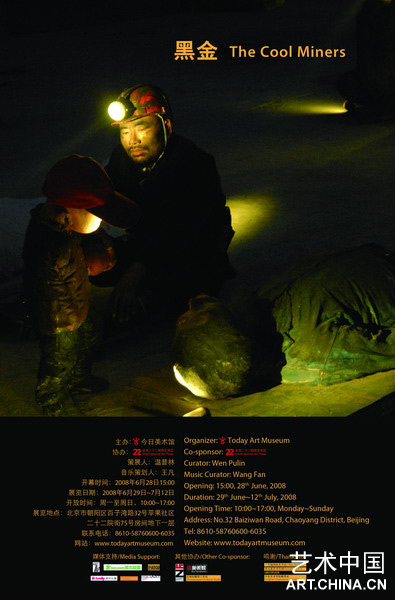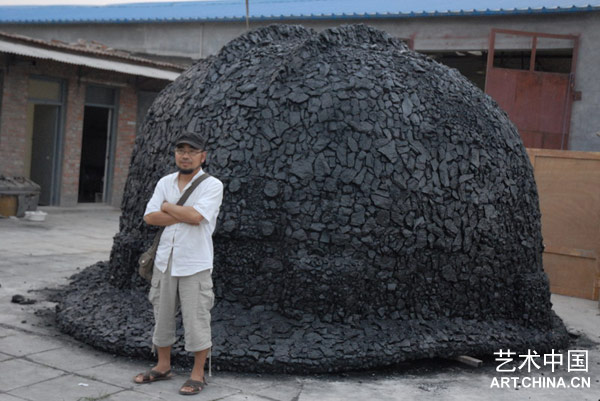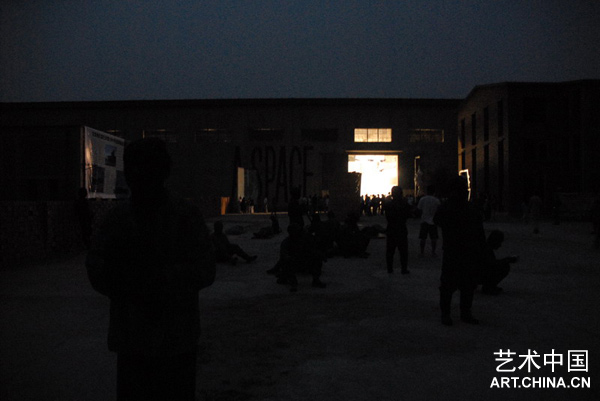
黑金 The Cool Miners
張建華個展 Solo Exhibition of Zhang jianhua
主辦:今日美術(shù)館
協(xié)辦:北京二十二院街藝術(shù)區(qū)
策展人:溫普林
音樂策劃:王凡
開幕時(shí)間:2008年6月28日15:00
展覽日期:2008年6月29日—7月12日
開放時(shí)間:周一至周日10:00—17:00
展覽地點(diǎn):北京市朝陽區(qū)百子灣路32號蘋果社區(qū)二十二院街75號房間地下一層
聯(lián)系電話:8610—58760600—6035
網(wǎng)站:www.todayartmuseum.com
Organizer: todayartmuseum
Co-sponsor: 二十二院街藝術(shù)區(qū)
Curator:wen pulin
Music Curator: Wang fan
Opening:15:00,28th june,2008
Duration:29th june~~12th july,2008
Opening Time:10:00—17:00,Monday—Sunday
Address:Room75,B1,22international Art Plaza
No.32 Baiziwan Road,Chaoyang District,Beijing
Tel:8610-58760600-6035
Website: www.todayartmuseum.com
其他協(xié)辦:雁南藝術(shù)機(jī)構(gòu)、墻美術(shù)館、莊塘村雕塑工作室
鳴謝:一號地國際藝術(shù)區(qū)、尚元素藝術(shù)空間、上海證大現(xiàn)代藝術(shù)館、中央美術(shù)學(xué)院雕塑系
張建華個人簡歷
黑金
溫普林
“黑金”是張建華一系列有關(guān)礦難作品的集成之作,他綜合了雕塑、裝置、行為甚至燈光音樂,為人們呈現(xiàn)了一處井下數(shù)百米的礦井現(xiàn)場。張建華的礦工是有力量的,他們沒有被過度的雕飾,也沒有進(jìn)行風(fēng)格化的處理,特別是一排齊齊整整躺倒在地的礦難尸體,更給人以強(qiáng)烈的感官刺激。張建華本人頭戴礦工帽,滿臉烏黑,平靜的躺在他的這些兄弟們中間。能稱之為兄弟,是因?yàn)樗c他們曾同吃同住同歡樂,同在井下五百米深處的黑暗中一起挖掘黑金。
藝術(shù)家張建華關(guān)注這些礦工的目光是平視的,是悲憫的,沒有獵奇,也沒有刻意的煽情,然而這種直接呈現(xiàn)是最有力量的。在這個藝術(shù)過分強(qiáng)調(diào)制造的時(shí)代,藝術(shù)品更多地呈現(xiàn)出一種光鮮靚麗的外表,如此粗糙、笨拙、不唯美的形式反而使得張建華的作品引起了世人更多的關(guān)注。
黑金是山西的煤老板們對煤的尊稱,巨額的利潤使得煤炭的身價(jià)甚至超越了黃金,煤老板們可以像當(dāng)年的人民公社購買拖拉機(jī)一樣成批量的團(tuán)購悍馬。張建華塑造的就是為這些煤老板們在地下挖掘黑金的人。
馬克思在資本論中論述金錢本質(zhì)的時(shí)候引用了莎士比亞戲劇中的一段臺詞,大意是說“黃色閃光的金子,你可以使黑的變成白的,丑的變成美的,雞皮鶴發(fā)的老婦變成妙齡少女……總之,金錢的每個毛孔都滴著鮮血”。然而,資產(chǎn)階級的經(jīng)濟(jì)學(xué)家說金錢是沒有屬性的,也就是說金錢本身是沒有善惡的。在這個資本的時(shí)代,簡單地去批判金錢已經(jīng)是沒有意義的了,藝術(shù)家也沒有力量去解決任何社會現(xiàn)實(shí)問題。張建華以自己的方式表達(dá)了對這個世界的悲憫之情,也讓讀到他的人們在日常的狀態(tài)下多了一份對于底層人文和生命的關(guān)注。
08年6月于東臺書院

Coal——the Black Gold
“Black Gold”is a collection of all the works of Zhang Jianhua. It comprises diverse forms of art like sculptures, installations, performances, even light and music which unfold before us a scene of coal mine shaft hundreds of meters down below the ground. Those miners are plain yet powerful, without any inappropriate polish or distinctive style but provide an intense sensory stimulus, especially the lines of corpses of those who were killed in mining disasters. Zhang, miner’s hat on head and face black, is lying among them with whom he has lived, shared time, and dug the “black gold” in the 500-meter-deep darkness together, just like brothers.
Without curiosity, superiority or any intentional sentiment, Zhang concerns himself in this certain group of people with sympathy, and this kind of direct expression is just the most impressive. In a time when people pay too much attention to the delicacy of artistic productions, the roughness and clumsiness of Zhang’s sculptures are, on the contrary, more eye-catching.
“Black Gold” is the respectful form of address for “coal” by the mine owners in Shanxi. Since the enormous profits have valued coal above even gold, they become rich enough to purchase batches of Hummers exactly like what The People’s Communes did to the tractors. But Zhang’s sculptures here are those miners who actually mine the “black gold” with their own hands for the owners.
In , Marx quoted a part of the lines from one of Shakespeare’s dramas which say: “Gold Oh, you are what magical. You can make old becoming few, ugly becoming is beautiful, black becoming is white, wrong becoming suits” and also, by himself, “Vicious blood trickles from every pore of money”. The economists, however, say that money has no attribute itself, or in other words, money belongs to neither evil nor good. It is meaningless to simply judge money in this capital-reigned era, and artists alone are powerless to change anything of the cruel reality. But Zhang Jianhua showed his sympathy for the world in his own way, and people who have ever come across his works would care a little more about those who live at the bottom of the society.
Wen pu lin

|

